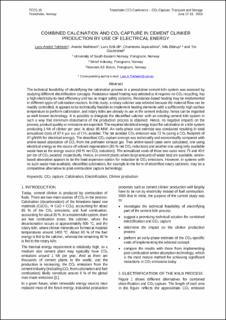| dc.contributor.author | Tokheim, Lars-André | |
| dc.contributor.author | Mathisen, Anette | |
| dc.contributor.author | Øi, Lars Erik | |
| dc.contributor.author | Jayarathna, Chameera K. | |
| dc.contributor.author | Eldrup, Nils Henrik | |
| dc.contributor.author | Gautestad, Tor | |
| dc.date.accessioned | 2020-02-25T08:41:39Z | |
| dc.date.available | 2020-02-25T08:41:39Z | |
| dc.date.created | 2020-01-17T11:52:39Z | |
| dc.date.issued | 2019 | |
| dc.identifier.citation | TCCS–10. CO2 Capture, Transport and Storage. Trondheim 17th–19th June 2019. Selected papers from the 10th International Trondheim CCS Conference. 2019, 101-109. | en_US |
| dc.identifier.isbn | 978-82-536-1646-9 | |
| dc.identifier.uri | https://hdl.handle.net/11250/2643542 | |
| dc.description | Published by SINTEF Academic Press 2019 This is an open access publication under the CC BY-NC-ND license | en_US |
| dc.description.abstract | The technical feasibility of electrifying the calcination process in a precalciner cement kiln system was assessed by studying different electrification concepts. Resistance-based heating was selected as it equires no CO2 recycling, has a high electricity-to-heat efficiency and has no major safety concerns. esistance-based heating may be implemented in different types of calcination reactors. In this study, a rotary calciner was selected because the material flow can be readily controlled, it appears to be technically feasible to implement heating elements with a sufficiently high surface temperature to perform calcination, and rotary kilns are already in use in the cement industry, hence can be regarded as well-known technology. It is possible to integrate the electrified calciner with an existing cement kiln system in such a way that minimum disturbance of the production process is obtained. Hence, no negative impacts on the process, product quality or emissions are expected. The required electrical energy input for calcination in a kiln system producing 1 Mt of clinker per year, is about 85 MW. An early-phase cost estimate was conducted resulting in total annualized costs of 67 € per ton of CO2 avoided. The net avoided CO2 emission was 72 % (using a CO2 footprint of 47 g/kWh for electrical energy). The described CO2 capture concept was technically and economically compared with amine-based absorption of CO2 from the preheater exhaust gas. Two amine-based cases were calculated, one using electrical energy as the source of solvent regeneration (85 % net CO2 reduction) and another one using only available waste heat as the energy source (48 % net CO2 reduction). The annualized costs of these two cases were 75 and 40 € per ton of CO2 avoided, respectively. Hence, in cement plants where large amounts of waste heat are available, aminebased absorption appears to be the least expensive option for reduction in CO2 emissions. However, in systems with no such waste heat available, electrified calcination, for example in the form of electrified rotary calciners, may be a competitive alternative to post-combustion capture technology. | en_US |
| dc.language.iso | eng | en_US |
| dc.relation.ispartof | TCCS–10. CO2 Capture, Transport and Storage. Trondheim 17th–19th June 2019. Selected papers from the 10th International Trondheim CCS Conference | |
| dc.rights | Attribution-NonCommercial-NoDerivatives 4.0 Internasjonal | * |
| dc.rights.uri | http://creativecommons.org/licenses/by-nc-nd/4.0/deed.no | * |
| dc.title | Combined calcination and CO2 capture in cement clinker production by use of electrical energy | en_US |
| dc.type | Chapter | en_US |
| dc.description.version | publishedVersion | en_US |
| dc.rights.holder | © The authors. | en_US |
| dc.source.pagenumber | 101-109 | en_US |
| dc.identifier.cristin | 1775675 | |
| cristin.unitcode | 222,58,3,0 | |
| cristin.unitname | Institutt for prosess-, energi- og miljøteknologi | |
| cristin.ispublished | true | |
| cristin.fulltext | postprint | |

